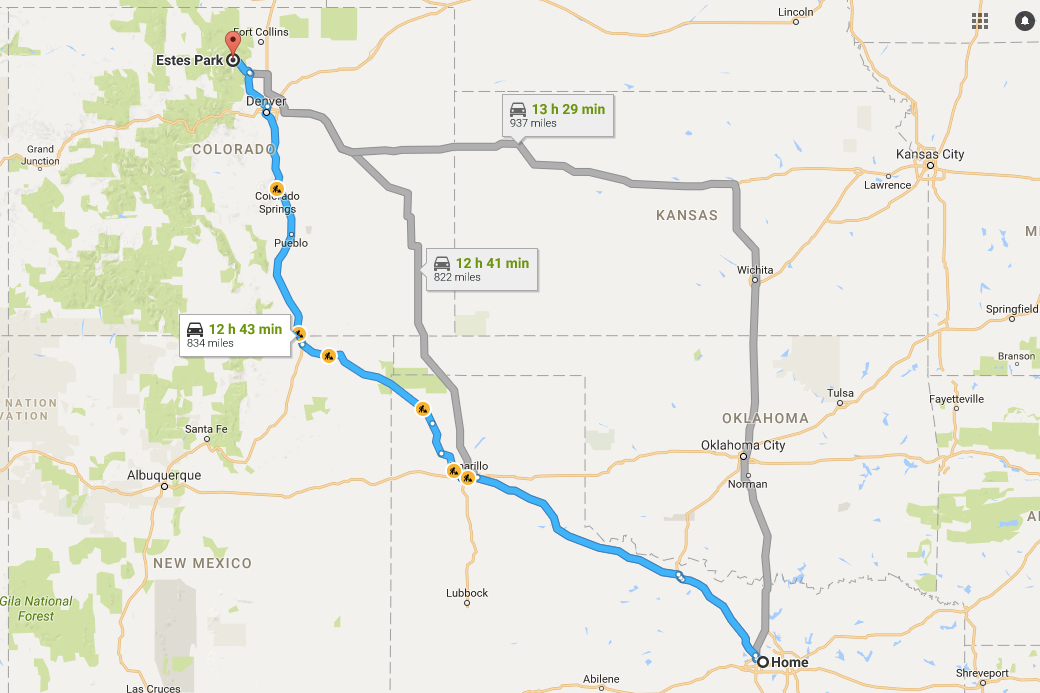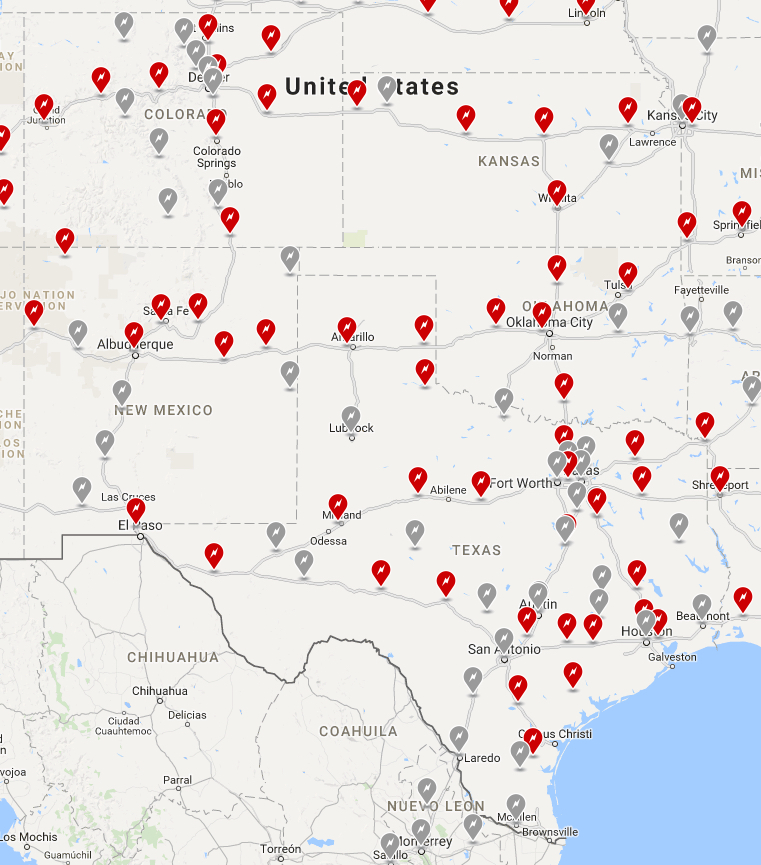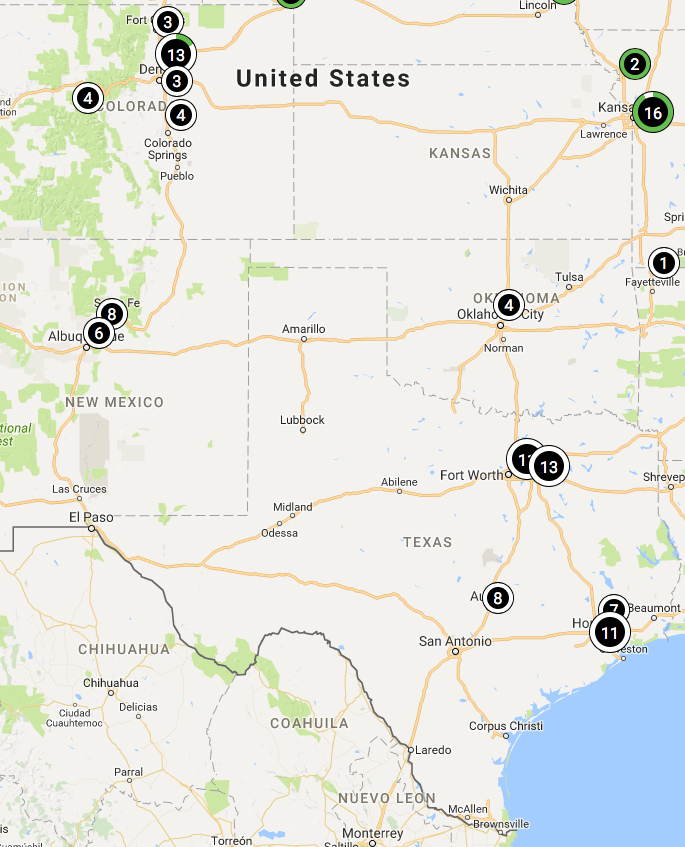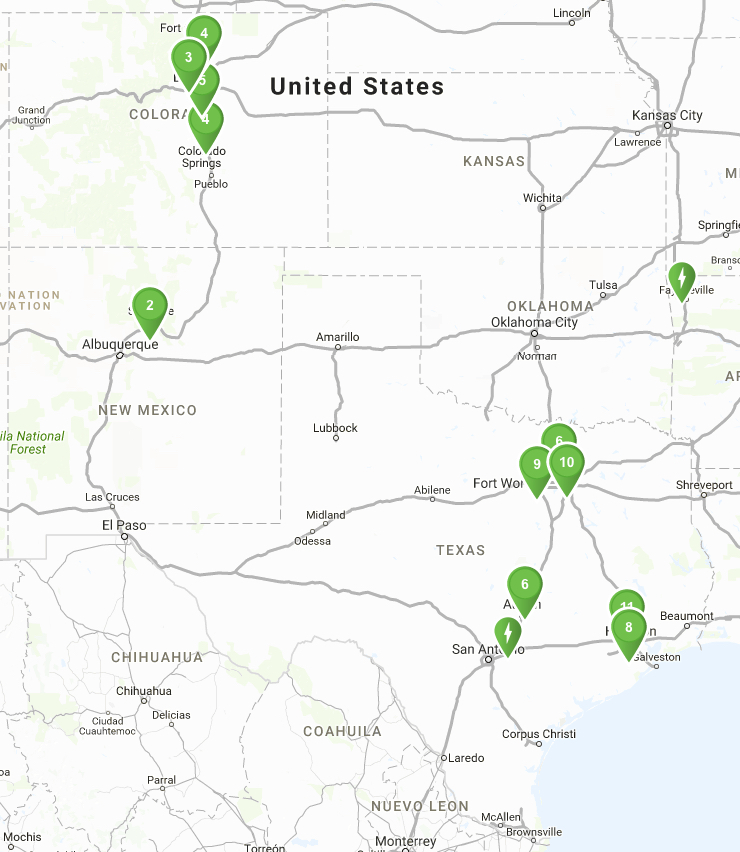I’ve been test driving a couple of the very few Bolt EVs I can locate, in my area of Texas.
Why so few, you ask? I’ll digress for a moment…
GM decided to do a phased rollout of the Bolt EV, beginning with California and Oregon and keeping its availability (mostly) limited to states that offer Zero Emission Vehicle credits through the first six months of availability (December 2016 – May 2017). Exceptions to this perceived pattern were:
- Virginia, in the 3rd month (proximity to Washington DC, perhaps?)
- Washington, in the 5th month (strong EV market, or just filling in the West coast?)
- New Hampshire, in the 6th month (Filling in the gap between Maine, Vermont & Massachusetts?)
- Colorado, in the 6th month as well (What were they smoking when they decided this?!?)
Although the rollout schedule didn’t make me very happy, my being in Texas (9th month Bolt EV availability), I understand the business decision. If GM wants to sell very profitable, big SUVs, trucks and sports cars, in the states governed by the California Air Resources Board rules (also known as CARB states), these credits make that possible.
Manufacturers, like GM, have to produce and sell a certain percentage of zero emission vehicles, out of their overall vehicle sales, in those states. This percentage changes over time, peaking at 22% of vehicle sales in 2025. This makes the credits quite valuable and has been derided by Elon Musk of Tesla Motors, as it gives an economic advantage to manufacturers that produce both ZEVs and gasoline-fueled vehicles. Think about it: Tesla does not make vehicles that run on fossil fuels. ZEV credits would seem worthless to Tesla, except for the fact that there is a market for ZEV credits. Tesla can sell their ZEV credits to other manufacturers, whose percentage of ZEV-to-internal-combustion-vehicle sales does not meet the CARB requirement. Mr. Musk’s issue is that, according to him, Tesla is only able to garner about half of the dollar value the credits have, for traditional vehicle manufacturers, giving those other manufacturers a competitive advantage.
Anyway, I was not happy about Texas’ position in the rollout schedule.
This month we got the great news that the ability to place orders for Bolt EV had moved up one month and I fervently hope deliveries will also commence a month earlier than originally planned. If so, I could be selling Bolt EVs as early as the 4th of July.
Think about the advertising possibilities: “Celebrate Gasoline Independence Day Sale!” Now back to our original programming…
Some people have gone to states, where Bolt EV is available, bought one and had it shipped home. I know of three, in my area of Texas. There are very few, because GM has threatened dealers with lawsuits, if they sell outside their defined territories. (There have been stories of Bolt EV being sold into other countries, not just other states.) This caused the well to dry up and kept the Bolt EV a rarity, in my neck of the woods. Fortunately for me, I have friends in EV places and have had some Bolt EV road time and thoroughly enjoyed it. Although the Bolt EVs exterior styling is not my cup of tea (I plan to keep driving my Volt), my wife loves it and is ready to give her 2015 Volt to our daughter, Zoe. We’d then trade Zoe’s 2014 Volt in, on a new Bolt EV purchase or lease.
That being said, the Bolt EV is a hoot to drive! I have witnessed the wheels break traction at 40 miles per hour! The roominess of the interior, which is mentioned in every review I’ve read, is impressive. Some of the Bolt EV drivers I know are over six feet tall and still have oodles of headroom in both the front and rear seating positions. The rearview mirror’s monitor display, reverse and forward parking cameras and the wrap-around camera (like you’re observing from a drone above your Bolt EV) are amazing. I hope those features make it to the Volt…
However, I’ve been thinking about the battery pack and the Bolt EV’s impressive range of 238 miles per charge. While it is great for bragging rights, as it was the first EV to have range like that, for under $70K…WELL below $70K, is that much range really necessary? (Bolt EV starts at $37,495 or $29,995 after the $7,500 Federal Income Tax Credit.)
How often do you drive more than 100 miles, in a single day?
GM representatives have stated that battery costs are down to around $145 per kwh (for GM) and are still falling. For a 2nd generation Volt, that’s $2,668 but the Bolt EV’s 60 kwh battery that’s $8,700!
Don’t get me wrong. I am proud GM was able to do this. It is impressive and the Bolt EV is an impressive vehicle, but let’s think about the use case for the BoltEV:
- It has a range of 238 miles per charge.
- With optional CCS fast charging, you can add 90 miles of range in 1/2 hour or fill the battery in 2-1/2 hours.
- Although not very common today, CCS fast charging is being deployed along major highways and in major metropolitan areas.
 Let’s take a trip from where I live, Fort Worth, Texas, to one of my favorite places, Estes Park, Colorado. The distance is 834 miles, most of it being freeway driving or mountainous terrain (after Boulder). We probably wouldn’t get 238 miles per charge, due to high speed and/or terrain, so let’s estimate 200 miles per charge. Here’s how that looks:
Let’s take a trip from where I live, Fort Worth, Texas, to one of my favorite places, Estes Park, Colorado. The distance is 834 miles, most of it being freeway driving or mountainous terrain (after Boulder). We probably wouldn’t get 238 miles per charge, due to high speed and/or terrain, so let’s estimate 200 miles per charge. Here’s how that looks:
- Start out at 8:00AM, with a full charge at home.
- Drive 200 miles @ 60 MPH, to Quanah, Texas (3 hours, 20 minutes – arrive 11:20AM)
- Charge 2-1/2 hours, grab lunch, walk around the area (if not just at a roadside rest area)…um…read for a while… Depart 1:50PM.
- Drive another 200 miles to Dumas, Texas (3 hours, 20 minutes – arrive 5:10PM)
- Charge 2-1/2 hours…Watch a movie in the car. Grab dinner, toward the end of the charge. Depart 7:40PM
- Drive another 200 miles to Trinidad, Colorado, passing through Raton, New Mexico (3 hours, 20 minutes – arrive 11:00PM)
- That’s 15 hours, so let’s stop for the night, I’m beat!
- Hopefully I booked a hotel with a level 2 charger (at least). Charge overnight for 9-1/2 hours* (more on this later) Depart, after breakfast, at 9:00AM
- Drive 200 miles to Denver, Colorado (3 hours, 20 minutes – arrive 12:30PM)
- Charge 2-1/2 hours. Have lunch. Depart 3:00PM.
- Drive 70 miles to Estes Park, Colorado (1-1/2 hours of twisting, sometimes steep, mountain roads – arrive 4:30PM)
That’s 22-1/2 hours of driving & charging (not counting the charge/stay at the hotel). Of course, that depends on several factors, including finding CCS fast chargers, that are not already charging other EVs, in Quanah, Texas (population 3,000), Dumas, Texas (population 14,691) and Denver, Colorado (should be easy), as well as finding a hotel, in Trinidad, Colorado with level 2 charging* (at a minimum).
How would this trip go, if driving my Volt?
I would save 5-1/2 hours. I’d still have to stop for lunch and dinner on the first day, although it would take no more than an hour to do so, each time. I’d also have to stop to buy gasoline, but that could be combined with some of the meal stops. Lunch on the second day would be at my destination, saving me 2-1/2 hours on that day alone. I would arrive at my hotel in Trinidad, Colorado at 8:00PM, instead of 11:00PM and in Estes Park around 2:00PM, instead of 4:30PM. More rested, with more time to enjoy Estes Park.
The difference, although substantial, is small enough that I might actually opt for the Bolt EV, to save on fuel, have peace and quiet & reduce pollution, if I had another person help with the driving. However, this may be too rosy a picture, if I have to spend even more time finding a CCS fast charger or wait for a charger to become available. Over time, as battery charge times are reduced and chargers begin to proliferate, this issue will diminish. I am sure this trip is not reasonably possible with today’s charging infrastructure. Unfortunately, as I saw in a recent presentation by the North Central Texas Council of Governments, although charging infrastructure is being planned, as can be seen here and here, the DC fast charging is mainly focused around urban centers and there are currently no plans to expand charging infrastructure along my route. In fact, the designated corridors require Texans heading West to go North and East, around Kansas to Nebraska and then turn West on I-80 to get to Colorado and further West.
That means that for the foreseeable future, the Bolt EV should not be considered a long distance vehicle. It is more than just a daily commuter, with occasional trips, since within Texas I could drive to:
- Houston (and on to Galveston Island with a 30 minute CCS fast charge)
- Austin (the State capitol and grooviest city in the state)
- San Antonio (home of the Alamo and Riverwalk, with a 30-45 minute CCS fast charge, in Austin)
- Corpus Christi, Texas (with an overnight stay, in Austin. That’s okay, as it is a long drive for just one day)
- Shreveport, Louisiana (if very careful or with an hour-long Level 2 charge)
- Oklahoma City, Oklahoma (if very careful or with an hour-long Level 2 charge)
Big Bend National Park, at the border with Mexico, and El Paso, Texas would become too far to reach in a reasonable time. Texas is a big state, in case you haven’t heard.
So the Bolt EV is pretty good for trips of less than 325 miles, one way, but beyond that, it becomes less appealing. This begs the question, “How often do you drive that far, in a single day?” In the 15 months I’ve had my 2017 Volt, I have gone to Austin once. Based on that, it would work for me. If it was my only vehicle, I’d have to rent a gas-powered vehicle for longer trips, take a flight instead or stay overnight somewhere along my route. There’s nothing wrong with that! Most of the time I go to Colorado, I fly. When I last drove to Corpus Christi, I stayed overnight in Austin, as I showed I’d have to do, in the Bolt EV.

The Tesla Model 3 is, according to the Tesla Motors’ Model 3 page, will have 215 miles of range per charge. That’s a small enough difference, when compared to Bolt EV, that the trip would be comparable to the Bolt EV trip outlined above, with this exception: Tesla has been and continues to roll out “Superchargers,” (or DC fast charging) infrastructure. General Motors has decided to leave that to 3rd parties, like ChargePoint, EVgo and others. Unfortunately, those companies appear to be focusing on large, urban areas, in order to maximize electricity sales and seem to be ignoring the areas between cities (i.e. “destination chargers”). The two maps below show ChargePoint and EVgo CCS fast charger locations. It appears that leaving the development of infrastructure to the free market will not generate what will be needed for inter-city travel, at least not yet.
There are multiple Supercharger locations, along the route from Fort Worth to Estes Park (see image above). Unlike the Model S and Model X, the Model 3 does not include free Supercharging. However, at last year’s shareholder meeting, Elon Musk announced the Model 3 would get free “long distance charging.” Although there was no clarification (Level 2 or Supercharging?) it would seem, since the “long distance charging” would not be that advantageous if it was not DC fast charging, that Model 3 owners would have access to the Supercharger network, shown in the image above.


Here’s my point: Most of us don’t need 238 miles of driving range. Surprise!
We don’t need the extra battery weight. We don’t need the extra battery cost. The longest regular commute any of my Chevrolet customers have is 50 miles, one way. They might be able to charge at work. Even without charging at work, a 30 kWh battery pack could suffice. At 119 miles of range (maybe more, since the Bolt EV would be lighter, with a smaller battery), even that person’s commute could easily be handled and the Bolt EV could be $4,000 cheaper, making the base model’s price $25,995 (after tax credit). For those with less than a 100 mile round trip commute, driving a Bolt EV is overkill. It’s like driving a traditional car that has a 75 gallon gas tank. You would either just be topping off the battery each day, never using the extra capacity for which you paid, or only charging one or two times a week.
Wait a minute. THAT’S THE ANSWER! Charging only once or twice a week!
One market that is difficult to penetrate with an EV, is the apartment dwellers. The Bolt EV would be a great fit for those who cannot charge at home, due to lack of charging infrastructure at their residence. Instead of daily charging, the Bolt EV would be handled like a gasoline car. You’d fill up once or twice a week. If CCS fast charging was made available at places where people would reasonably be expected to stay for at least an hour (sport venues, restaurants, movie theaters, grocery stores, shopping malls, schools and their job), the Bolt EV or Model 3 could open up a previously impossible market for EVs.
Other segments of the market that have been DYING to drive electric, but haven’t been able to yet, include young people, at the beginning of their career, who live in apartments, and retirees who live in retirement communities or assisted living facilities. The last issue to resolve for these groups is the income tax credit. It tilts the market to more affluent buyers, who have enough of a tax burden to get the full benefit of the credit. If we changed the tax credit to a point-of-sale discount, regardless of income level, demand could increase dramatically. We need to do this!
*One last thing: I mentioned hotels with chargers. When I am booking a hotel, I always ask if they have chargers for electric vehicles. If they do not, I say, “I can’t book with you because I need to plug in my EV.” If they say they have chargers, I always say, “Great! I’ve been looking for a hotel that provides a place to charge my car!” Since I drive a Volt, that’s not exactly true, however businesses may not know the draw a charger can have for new clientele. EV owners are thought to be affluent, thanks to Tesla, so we’re a market they’re dying to dominate. Please do this when you book your next hotel reservation. If you visit an establishment that has a charger for their customers’ use, please ask for a manager and thank them for it.
The more we all do this, the more useful our vehicles become and more people will feel comfortable making the jump to electric driving.



I drove from Tacoma Washington to Portland Oregon last weekend in my Bolt EV. I could’ve made it with the charge I left the motel with, but I was driving it hard at 77 miles an hour and forgot I left Hilltop Reserve so the battery was not completely full.
Along interstate five (I-5) north and south in Oregon we have plenty of CCS chargers. The problem here is all the chargers are 24 kW.
For road trips you need a charger greater than 50 kW so the battery can be full in an hour or less.
Hopefully the new chargers to be installed by Volkswagon as part of the dieselgate settlement will fix this!
Love my Bolt EV’s driving dynamics. It can be a real road warrior if that is your driving style.
Charge on!
Great post, Buzz! Whether it be the types of differrent vehicles themselves, or residence to destination charging, we need to keep showing consumer demand.
Whether it be the types of differrent vehicles themselves, or residence to destination charging, we need to keep showing consumer demand.
We are very happy with our Bolt EV. My wife has a 100 mile round trip commute twice a week. She has a shorter commute the other three days. We put a level 2 Clipper Creek charged in our garage for around $1,000.00 including electrician.
The only “issue” has been Southern Cal Edison. We have some of the highest electric rates in the country. We put a 4 kw solar array on our roof shortly after buying our Southern Ca. Home 1 year ago. While we were told by the Sokarvinstalkers they could “add more pannels” for the EV we planned to purchase when the time came they said no.
Southern Ca. Edison wants you to add a second meter ($2,500) to get the lowest rate but they won’t allow both meters to “net meter” or take advantage of your solar gains.
So we have a three tiered rate system with prices depending on both time of use and total kilowatt hours per month. The tiers are 1-768 kWh @ .14 cents per kWh, 769-1,057 @ .25 cents per kWh, and anything over that at .35 cents per kWh!.
Our EV uses about 480 kWh per month so depending on time of year we may get into tier 3 for part of the month.
So SCE will allow us to add a second solar array, but only to “cancel out” our past 12 month’s average usage. That is why our first array was only 4 kWh. We now need about an additional 8 kw system to cancel out our “overages” ( SCE does not bill solar customers for “overages” meaning use over your solar output until the 12th month after installation. Then they hit you with a huge bill all at once. ( About $1,500.00 in our case).
So the “problem” is that SC Edisons policies approved by the California PUC discourage both Solar Arrays and EV adoption by limiting access to both net metering and allowing customers to build a single solar array that is based on projected rather than pre joys usage. Still much cheaper than gas though!
I thought California was all about renewable energy! Those rates are horrendous.
How does SC Edison justify $.25-.35/kWh? Is SCE billing out the cost of decommissioning a nuke plant or building a new one, or what? Something unusual is going on.
Various areas of the country have vastly different electric rates. Texas broke the industry into three segments, power generation, power transfer and electric retailers. The electric retailers have to compete for customers because the state set up http://www.PowerToChoose.org, a website where the rates are stated in the exact same terminology for every provider. No more hiding behind obscure rate equations. In some rural areas, end users have no choice, as they are in an electric “cooperative.” Those areas have so few customers, that competition isn’t feasible.
One downside of this setup, is the law stating that only electric retailers can sell electricity to the end-user at a per kWh rate. Due to this, companies providing public EV chargers have started charging by connected time. This gives some EVs an advantage over others. For instance, the Volt charges at half the speed of the Leaf. A leaf driver would therefore pay 1/2 as much for an equivalent charge on a Volt.
The Bolt will be great for our regular trips to Austin, as well as trips to San Antonio and Oklahoma.
But a trip to Houston as it is today would be nerve wracking. There is basically no L2 or CCS charging on I-45.
I wish I could just buy a few charging stations, contact a gas station in Centerville and offer it to them for free. Since the Bolt has such a long range, just 1.5 hours at a 7.2 kW L2 station or .5 hours at a CCS station would be enough extra range to make the trip stress free!
It needs to be at a restaurant, like Sam’s in Fairfield. I love that buffet!